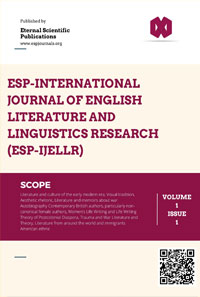ESP International Journal of English Literature and Linguistics Research (ESP-IJELLR)
Citation :
Gayathri S, S. Kavitha, 2025. "Machine Translation vs. Human Translation: Quality, Challenges, and Perceptions" ESP-International Journal of English Literature and Linguistics Research (ESP- IJELLR) Volume 3, Issue 2: 24-30.
Abstract :
Language is a primary resource for people when constructing, negotiating and expressing their social identities; it does more than convey of meaning. Specialized language use such as slang, jargon and sociolects represent most noticeable linguistic means that the urban youth employ a lot for cultural positioning, affiliations to peer group and identity formation. Being as slang is informal and often fleeting, it’s a means of creative expression for young people — without it they cannot easily show off their individuality while still demonstrating that they are part of the group. Arising within heterogenous affinity groups and substructures, jargon mirrors common attitudes, activities and understanding of specific social areas, enabling more expedited forms of communication among those they apply crossing official language boundaries. One of these sociolects, as regions et the ne new youth identities Bewertungen zips as 2001;) schü Developmental science has to do with urban youth being characteristics (difrogger v2.0 widening-access spit for printer friendly version Introduction Such speech styles can be an even better indicator of urban youth identity, taking into consideration such factors like age, race, class and regiona.Taking a social, cultural and performative approach to the analysis of multilocality, this research explores how slang, jargon and sociolect affect urban teenagers' identities. The research is based on a mixed-method methodology: qualitative interviews; discourse analysis of online and off-line communication; and a quantitative survey of 200 urban teenagers. Such language patterns are, the research claims, both expressions of identity and strategies for social bonding, agency and resistance. Slang is rapid changing and serves as a medium for trial and error as well as creativityas itis often influenced by the media, popular culture, interaction with peers. Jargon is a way of life, and essential for community-building (huge particularly online/in internet subcultures). Sociolects, however, are indicative of peer-group norms and local urban culture fixing the identity with youth language across social contexts.The findings show the dynamic relationship between language, culture and society in urban areas. Urban youth language, the study says, is a performative social practice which allows young people to navigate issues of (dis)identity, solidarity and power in these quickly changing cultures. And on top of that, social media and digital communication dramatically accelerate the propagation and mutation of slang and jargon, turning us all into flexible, context-driven language machines. Greater inclusion of youth voices in academic and social discussion, greater sociolinguistic understanding of urban youth cultures, as well as more informed educational practices and policy frameworks are all enabled by recognizing the significance of these vernacular practices.
References :
[1] ACL Anthology. (2024). Comparative analysis of machine and human translation quality. Proceedings of the EAMT Conference. https://aclanthology.org/2024.eamt-1.42.pdf
[2] ArXiv. (2020). Challenges of negation in neural machine translation. https://arxiv.org/abs/2010.05432
[3] PLOS ONE. (2023). Machine translation post-editing: Efficiency and quality assessment. https://journals.plos.org/plosone/article/file?id=10.1371/journal.pone.0328511&type=printable
[4] ResearchGate. (2024). User perceptions of machine vs human translation. https://www.researchgate.net/publication/394454281
[5] Koehn, P. (2020). Neural machine translation. Cambridge University Press.
[6] Vaswani, A., et al. (2017). Attention is all you need. Advances in Neural Information Processing Systems, 30, 5998–6008.
[7] Toral, A., & Way, A. (2018). Overview of the quality of MT vs human translation. Machine Translation, 32(3), 159–182.
[8] Wu, Y., et al. (2016). Google’s neural machine translation system. arXiv preprint arXiv:1609.08144.
[9] Bahdanau, D., Cho, K., & Bengio, Y. (2015). Neural machine translation by jointly learning to align and translate. arXiv preprint arXiv:1409.0473.
[10] Popović, M. (2018). Evaluation of MT quality and post-editing. Language Resources and Evaluation, 52, 1–25.
[11] Carl, M. (2019). Post-editing for professional translators. Translation Spaces, 8(1), 60–83.
[12] Costa-jussà, M. R., et al. (2021). Advances in low-resource machine translation. Computational Linguistics, 47(1), 1–34.
[13] Koehn, P., & Knowles, R. (2017). Six challenges for neural machine translation. arXiv preprint arXiv:1706.03872.
[14] Tiedemann, J. (2019). Parallel data and translation quality for low-resource languages. Language Resources and Evaluation, 53, 1–20.
[15] García, I., & Pena, M. (2011). MT in legal translation: Challenges and solutions. Machine Translation, 25(3), 197–219.
[16] Chiang, D. (2005). A hierarchical phrase-based approach to MT. Computational Linguistics, 33(2), 201–228.
[17] Bojar, O., et al. (2016). Findings of the WMT16 shared task on machine translation. Conference on Machine Translation.
[18] Specia, L. (2011). MT evaluation in the real world: User-oriented approaches. Machine Translation, 25(3), 197–219.
[19] Way, A. (2013). Quality expectations in professional translation workflows. Translation & Interpreting Studies, 8(2), 1–25.
[20] LDC (Linguistic Data Consortium). (2020). Multilingual corpora for MT training. https://www.ldc.upenn.edu
Keywords :
Neural Machine Translation Post-Editing, User Perception of Machine Translation and Human Translation, Quality In Translation, Difficulties in Translation, Cultural Sensitivity Intranslating, Hybrid T Ranslation Linguisticaccuracy.


 :10.56472/25842773/IJELLR-V3I2P104
:10.56472/25842773/IJELLR-V3I2P104